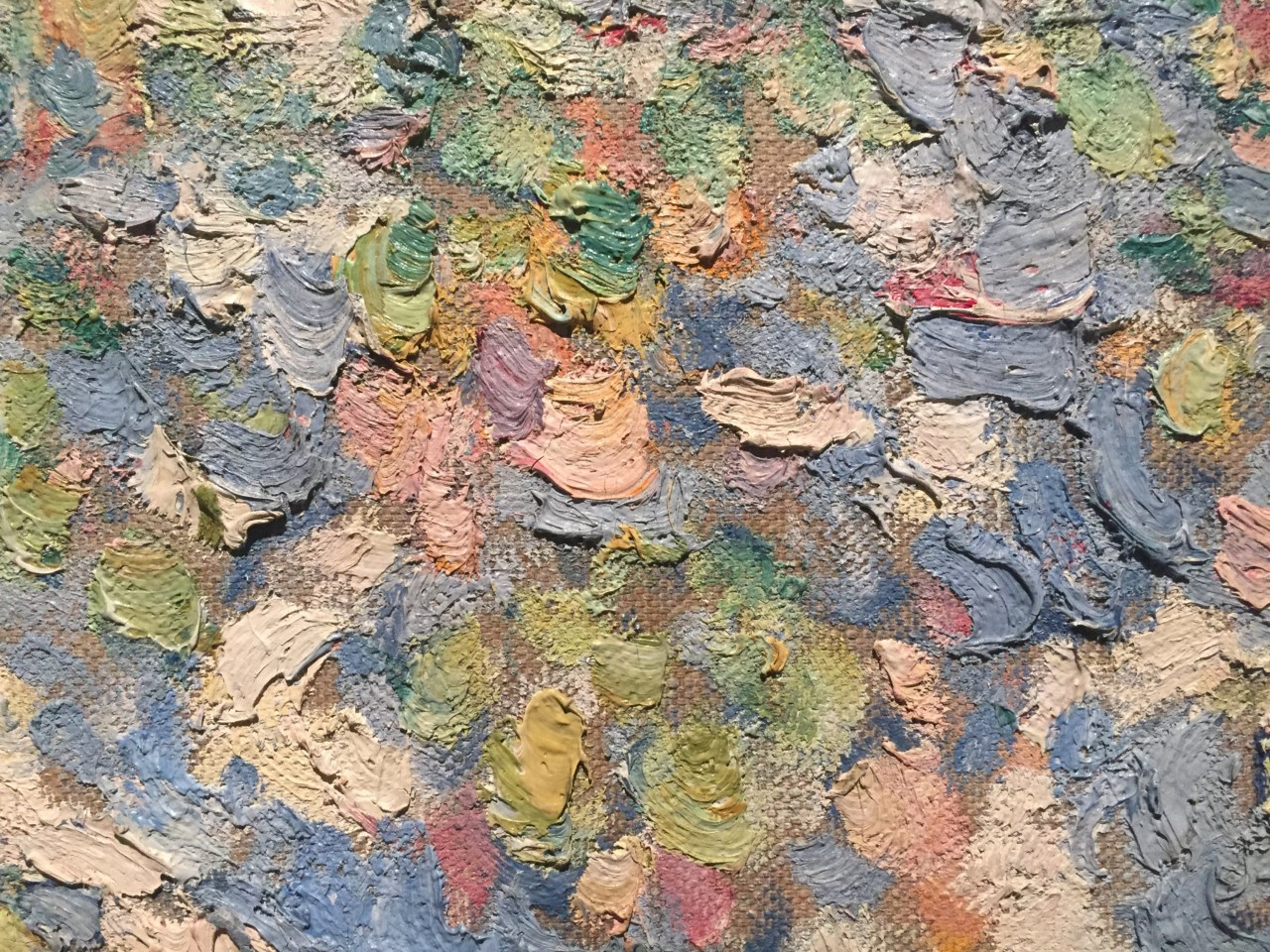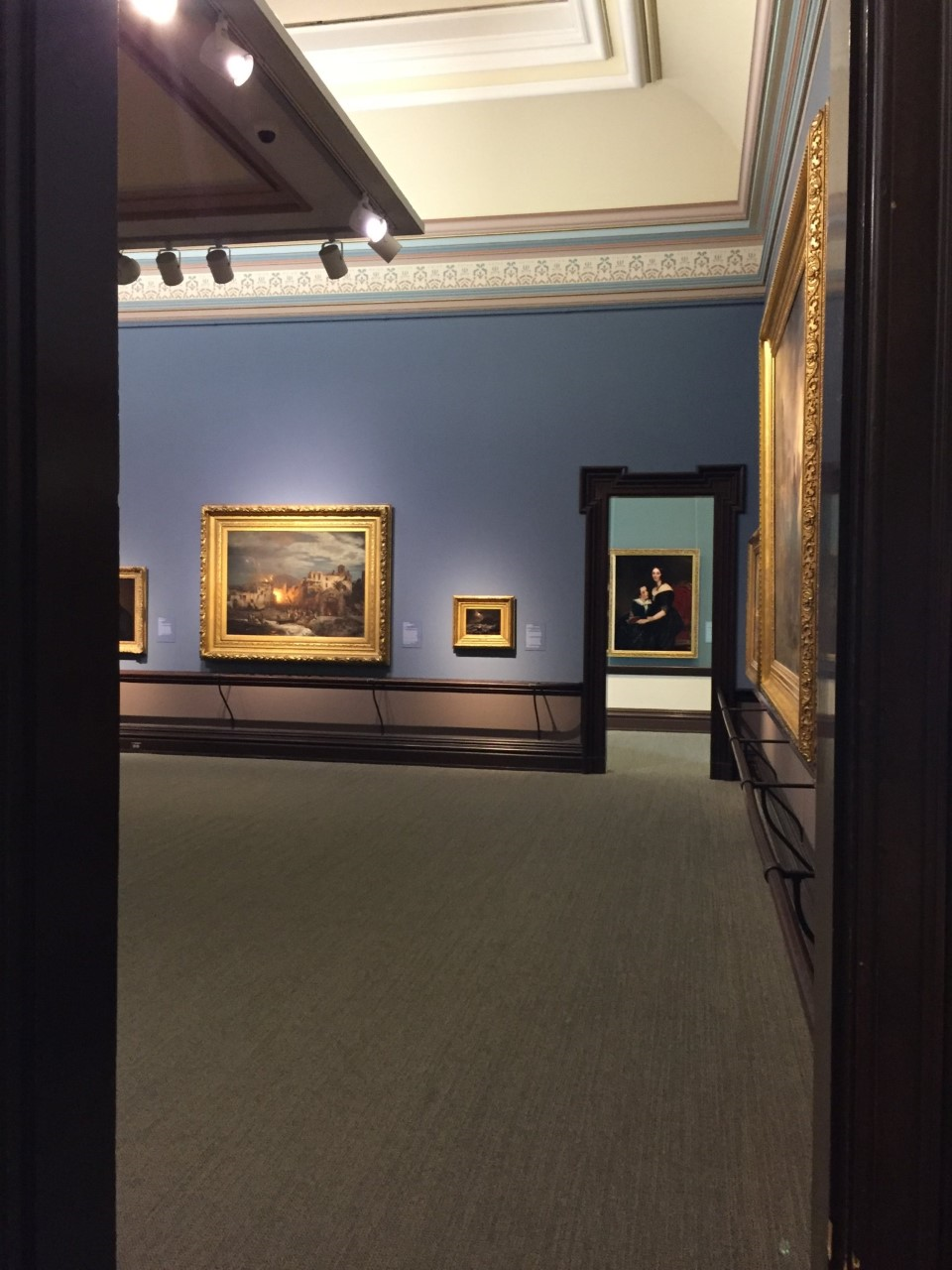I always wonder what other curators look at or look for when they are walking around museums. Do they focus on finding the work of specific artists on the walls or finding paintings from distinct periods in time while strolling through galleries? Do they look for themes or objects that show an artist’s adventures in risk-taking? Is medium a major point of focus or do curators narrow in on works that are aesthetically pleasing when scanning an exhibition?
The answer to these questions is likely both yes and no. For me, it depends on the museum, the goals of the visit, who I am with, and how much time I have set aside to roam the galleries.
I joined the Crocker Art Museum about six months ago as Associate Curator and I work extensively with the photography, Native American, and American works on paper collections. As a relative “newbie” to the Museum, I like to explore the galleries and to look for the small details in works of art. It could be a delicate and small detail that catches my eye or an artwork that is bold and big. I am often looking at wall colors, where seats are placed, layout, and lighting when I visit the galleries. I look for evidence of the choices that Museum staff have made and the choices that visitors make while looking. Sometimes my focus is on frames, pedestals, staircases, and flooring, while other times I am more attuned to the architecture.

The Crocker's new permanent collection photography space, which rotates every six months.
In this time away from the physical museum building, I decided to reflect on my own experiences as a museum visitor. I turned to my phone to see what I documented at the Crocker over the last few months. What caught my attention? I hope you’ll recognize some the details on this “Curator Tour.”
I find Edwin Deakin’s Roses calming, serene, and just plain lovely (top image). I like to stop and look at the shades of pink and ways in which the flowers fall around the vase. The ways in which this still life painting mirrors Dutch still life paintings of the 17th century also catches my eye. Deakin’s Roses is a good art historical reminder of the artists who worked in this genre centuries ago and their attention to exquisite details.

Peter Combe (Canadian, born 1962), Dick (detail), 2016. Mixed media (appropriated paint swatches), 48 x 48 in. Crocker Art Museum, gift of Joy and Ed Gough, 2018.17.
The details of Peter Combe’s work, Dick, 2016,
made of appropriated paint swatches, force me to stop and think about how
seemingly mundane materials and objects from our everyday lives can be used
differently or creatively. It is exciting when artists take color and create
line and form. The idea of a near three-dimensional portrait made of materials
which originally had no three-dimensional purpose serves as a reminder of the
ingenuity of artists.
Materials can also take traditional form and still catch the eye, especially when they are made purposefully visible. The dabs of oil paint that create Joseph Raphael’s Untitled (Belgian Home in the Cabbage Field) are in many ways similar to Combe’s paint chips: the individual colors merge together to create a tranquil landscape scene. When viewed from a distance this seemingly abstract mesh of pink, green, blue, lavender, and cream form heads of cabbage in a field.

Joseph Raphael (American 1869–1950), Untitled (Belgian Home in the Cabbage Field) (detail), n.d. Oil on canvas, 27 x 37 in. Crocker Art Museum, promised gift of the daughters of Erna Helgesen Freyling Dybdal.
The same intensity of color and distinct use of materials draws me to Jennie Crocker’s Tiffany & Co. brooch from roughly 1880. The amethyst glows in the light and reveals the head of Medusa, best known for her wild hair made of snakes. A figure from Greek mythology, Medusa had the ability to turn humans into stone. She was also a protector and, in the late 19th century, was a popular symbol for dispelling evil and keeping individuals out of harm’s way.
The brooch is an important object of Crocker Art Museum and Crocker family history as it belonged to Jennie Louise Crocker, the fourth child of E. B. and Margaret Crocker. Jennie married Jacob Sloat Fassett in February 1879 and moved to Elmira, New York. Fassett was a state senator in New York and secretary to the Republican National Committee. Together, Jennie and Jacob owned seven gold mines in Korea. Jennie is important to the Museum’s history, as she helped fund the acquisition of the Crocker family home for museum purposes and founded the Asian area of our collection with her donation of Korean ceramics.

Tiffany & Co. (United States, opened in 1837), Jennie Crocker’s Amethyst and Diamond Brooch, ca. 1880. Amethyst, diamonds, and platinum, 1 5/16 x 1 7/16 in. Crocker Art Museum, gift of Margaret Ellis Langford and Rutherford L. Ellis, Jr., 2008.61.1.

European galleries in the Crocker Art Museum’s historic wing.
The same focus on detail extends to aspects of architecture, design, and use of space. The Crocker’s historic wing provides numerous opportunities for engaging in close looking, for stopping to consider details, and for reveling in carefully planned sightlines — a painting perfectly framed by an open doorway, for instance. The ways in which the wall colors, frames, architectural details, and the visible paintings work together to create a visitor experience always stop me in my tracks.
Beyond color, layout, or materials, I also look for creative ways to interact in museum spaces. Often, I spend time exploring how a museum engages with visitors beyond its physical walls. Education initiatives, whether online experiences or tangible take-aways like sketch cards for kids, are important to my own curatorial practice. I am always looking for ways to collaborate with educators in a joint effort to make museum visiting meaningful.
This “tour” through my photos might mirror your own or it might be completely different. Ultimately, that is the beauty and excitement of a museum visit. There isn’t one take-away or right way to experience the Crocker; every visit holds new possibilities and is entirely dependent on the visitor’s approach. As a curator, I hope to continuously add to the possibilities and to make those options both informative and intriguing.

Crocker Art Pack label located next to Romare Bearden (American 1911–1988), Mother and Child, 1968. Mixed media on board, 39 7/8 x 29 7/8 in. Crocker Art Museum purchase, 1973.24.
Bring the Art Pack or your library checkout receipt to the Crocker for FREE admission. There, you can explore the galleries and see the works highlighted inside the Art Pack, and take pictures of your own favorite things. Be sure to tag @CrockerArt.
Top Image: Edwin Deakin (British-American, 1838–1923), Roses (detail), 1912. Oil on canvas, 30 3/16 x 20 1/4 in. Crocker Art Museum, long-term loan from the California Department of Finance, conserved with funds provided by Gerald D. Gordon.
Jayme
Yahr, Ph.D., is Associate Curator at the Crocker Art Museum and a specialist in
American art, with an emphasis on the late 19th and early 20th centuries. She works
extensively with the museum’s photography, Native American, and American works
on paper collections.
Yahr
holds a M.A. in Art History from the University of California, Davis and a
Ph.D. in Art History from the University of Washington. Prior to joining the
Crocker Art Museum, Yahr designed and directed university-level Museum Studies
programs in New Hampshire and Minnesota.


